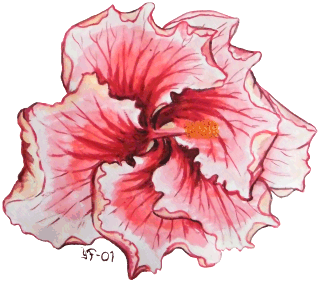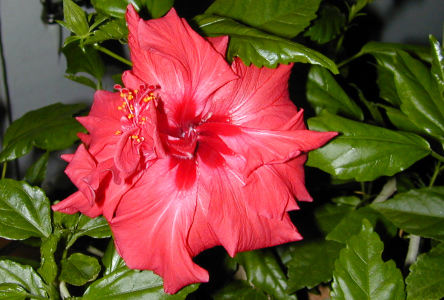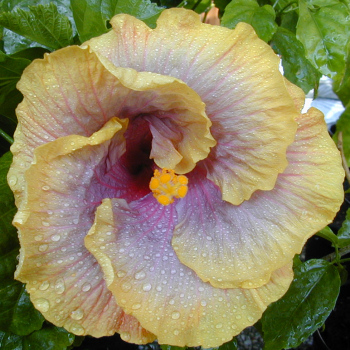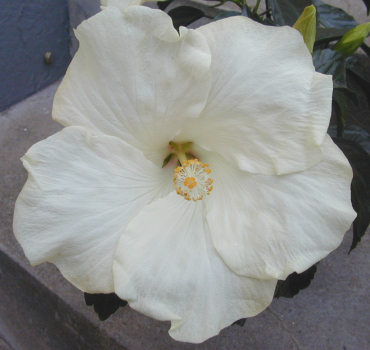
 |

|
Please note: Although much of the advice in this article is generally applicable to winter weary hibiscus, itís especially geared towards the production of show flowers. Hence some of the advice may be considered extreme to the average grower for whom early bud setting is not at premium. In a month or so the show season is upon us. But here you are now and your hibiscus not only look a bit shabby Ė thereís not a bud or flower in sight. Take courage, thereís hope yet! | |
WarmthThe first step to get your winter weary hibiscus out of the doldrums is warmth. If you want show flowers this spring you cannot wait until the weather improves on its own. Select your most promising plants and if you can arrange for some bottom heat, great, if you have access to a heated greenhouse, even better. If neither is a possibility for you, you might think of selecting a few of your hibiscus and bring inside to share your own living space. Place as light as possible and look out for cold drafts. |  |
LightTo get hibiscus into bloom, they also need light. 2-4 hours of direct sunlight is a minimum, at this time of year you may want to up that to at least 6 hours. If youíre growing your plants indoors, place at the lightest window you possess. You may have to augment with artificial light. Keep artificial light as close to the plants as feasible without burning them. Fluorescent light, preferably in the cool spectrum, is always a reliable source. Artificial light may be kept on up to 24 hours a day. | |
 |
RepottingA bit of stirring up is not a bad thing to get your hibiscus to rub their eyes and start growing again. Hence repotting is an important step to get your plants going. Repot in light but rich soil suitable for hibiscus. Since you want flowers as soon as possible, pot size is important. The rootball, after removing part of the old dirt and any damaged or overgrown roots, should fit comfortably but not snuggly into the pot. If you have more than half an inch of play between rootball and pot you might wish to go down a size. Why? Because if your plants are too busy developing their root systems, they wonít send up those growth hormones into the branches, where they will trigger bud production, but keep them to grow more roots. |
PruningAmazing as it might seem, cutting back your plants will improve flowering. This is due not only to increased branching but also to altered hormone levels. However, if you want flowers for early spring shows, do not prune those plants you hope will produce flowers for, say, the April AHS show. A general rule of thumb is 4-6 weeks from pruning before you see the first microbuds. This is a fact no matter how gentle your pruning, even if itís only a pinch. From that stage you have to count another 2-4 weeks, depending on variety, before you have fully developed flowers. That means that if you prune today, you will begin to get flowers in 8-10 weeks or so. Hence you may want to stagger your blooming by only pruning a few branches or plants at the time. Thus you will have a new flush of flowers every two weeks or so. | |
PotassiumMany hibiscus show enthusiasts have experimented with added potassium (the K in your fertilizer) as a means to intensify petal color but, there is an even more compelling reason to apply extra potassium to your plants. Potassium not only strengthen the plants immune system, it also play a part in breaking growth dormancy. When plants stop developing, the reason is an increased amount of abscisic acid. Cooler weather is one trigger that produces this inhibiting hormone. Unfortunately, this hormone also inhibits plant uptake of potassium, hence larger than normal amounts of potassium will be needed to bring the plant back into growth. Potassium can be applied either to the soil or as a spray onto the leaves, as it is absorbed either way. Since some potassium sources are high in salts, it may be best practice to apply extra potassium as a spray on application. |  |
Rooting HormonesPerhaps it seems totally crazy to recommend rooting hormones to already established plants but, this is yet another way to improve flower production. How? Surprisingly, the same hormones responsible for root growth are also responsible for flower and seed development. Hence, by adding rooting hormones to your newly repotted plants, you not only help them reestablish their root system, you also aid the blooming. There are several different rooting hormones on the market and it doesnít matter that much which brand you use. You should dilute the hormone to about 1/10 of the recommended strength for rooting cuttings. Water with it once a week until you see tiny buds forming. | |
 |
Gibberellic AcidAs we have discussed in previous articles, hormones are what make plants grow and flower. When plants stop flowering, as in winter, growth inhibiting hormones are mostly at play. To get your plants out of this inertia, you can artificially apply hormones that will do the job. Gibberellic acid is the hormone you want. It can be found at well assorted garden centers and also through mail order. Be aware that this hormone is very strong, so donít be surprised finding ready to use sprays having a concentration around 0.005%. Spray leaves and tips of branches, repeat once a week until you see new growth developing. Caution: Overuse of gibberellic acid may result in weak, lanky or spidery growth. If this happens, stop using the hormone and cut back the affected branches. |
You donít have to try all these tricks to get your plants ready for the spring show season and using them is not a guarantee that you will have flowers to exhibit at the first show of the year. They will, however, increase your chances to have blooming plants when show time comes around. Try one or try them all. In the end your success depends on You. Good luck and may all your flowers be showstoppers! | |
--------------
This article was previously published in Redstick's Gleanings Volume 8, Number 1, January/February 2011.
Disclaimer: Above advice is to be considered for guidance only. Although trying to be as correct as possible,
the author does not accept responsibility for any adverse results caused by following them.